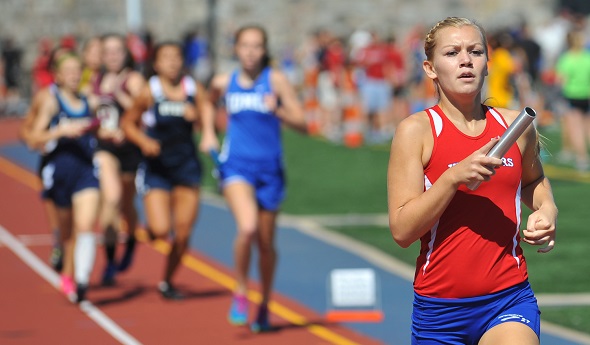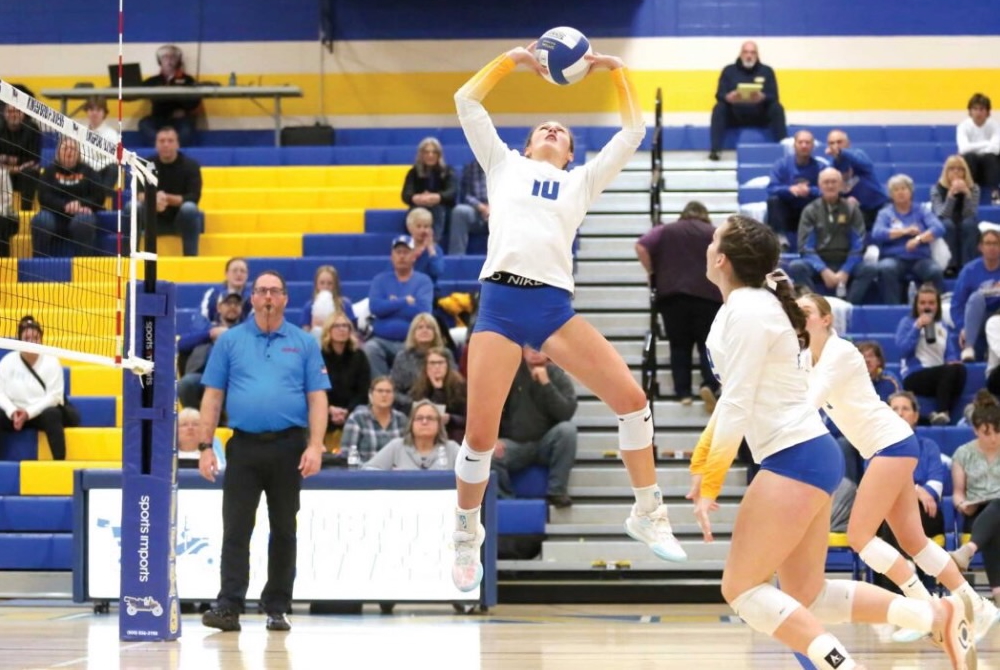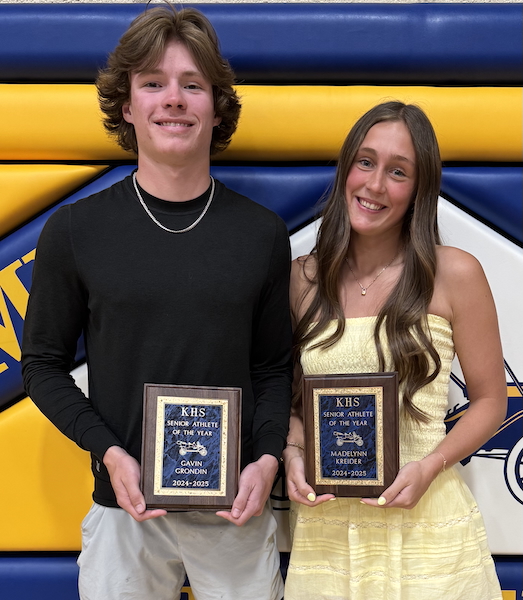
Chip Hills Caps Perfect Season Perfectly
May 31, 2014
By John Leerar
Special to Second Half
GRAND RAPIDS – Remus Chippewa Hills coach Sally Schafer wasn’t optimistic about her team’s chances halfway through the MHSAA Lower Peninsula Division 2 Finals on Saturday at Houseman Field.
“Things weren’t going the way I thought they had to go the first half of the day,” Schafer said. “I thought we were going to have to score in the upper 40’s to win. And even with a perfect second half of the meet, that wasn’t going to happen. It was going to be an OK day.”
When asked where she thought her team would finish at that point in time, Schafer responded, “Third or fourth.”
However, the lower-than-anticipated point total turned out to be enough, as the Warriors won the meet and their first MHSAA Finals title with 34 points. Lansing Waverly was second with 31.
Chippewa Hills did not win a single event, but scored points consistently enough to build a lead.
“We scored in six events today, which is the most we’ve ever scored in since I’ve been coaching,” Schafer said. “All of the girls came through at the end and ran consistently across the board today. We faltered a little bit, and were disappointed here and there, but when it came down to the last race, they got it done and did what they needed to do.”
 The race Schafer was referring to was the 1,600 relay, the last event of the afternoon. The Warriors came into that race 10 points ahead of Waverly, the top seed for that event. Chippewa Hills had to place in the top eight to secure the championship and did so, finishing sixth in a time of 4:03.87.
The race Schafer was referring to was the 1,600 relay, the last event of the afternoon. The Warriors came into that race 10 points ahead of Waverly, the top seed for that event. Chippewa Hills had to place in the top eight to secure the championship and did so, finishing sixth in a time of 4:03.87.
Senior Megan O’Neil was a major contributor for Chippewa Hills, scoring 16 points by herself with second-place finishes in the 800 and 1,600 runs.
“It hasn’t sunk in yet that (the 1,600) was Megan O’Neil’s last race,” Schafer said. “But she’s going to go on to bigger things. I’m sure she’s very happy her high school career ended like this.”
Schafer also made sure to give credit to her entire team. “This championship still took our entire team. We had 10 girls here today who all helped us win,” she added.
Chippewa Hills finished the season unbeaten.
The LP Division 2 1,600-meter record fell at Houseman Field. Junior Karrigan Smith of St. Johns edged out the previous record of 4:51.67 in that event, running a 4:51.53 while beating the rest of the field by more than two seconds.
“It’s such a great feeling,” Smith said. “This is the first state championship in my school’s history for the girls, so it’s a really important moment for me as well as my team. I’m just so thankful to be here.
 “My goal during the race was to stay behind the lead girl and kick it in the last 200 meters. I’m just happy that I could execute today, and it’s a great feeling. I had no idea I was even close to the record until my teammates informed me.”
“My goal during the race was to stay behind the lead girl and kick it in the last 200 meters. I’m just happy that I could execute today, and it’s a great feeling. I had no idea I was even close to the record until my teammates informed me.”
Spring Lake also made its presence known. The sister duo of Allie and Gabriella LeRoux took first and second, respectively, in the pole vault. Allie, a senior, finished with 11 feet, 8 inches, while her freshman sister Gabriella vaulted 11-5. Junior Carlyn Arteaga won the 800, finishing in 2:16.09.
“I’m happy with my performance today,” Arteaga said. “I’m glad everything worked out. My best time before this was 2:17, so this is a PR (personal record) for me. I qualified for the 400 as well as this race, but I decided to just concentrate on the 800. I wanted to go all in on this race and it paid off. I just started running the 800 as my main event this year, so I’m very happy about how it turned out.”
Senior Brittany Casey of Zeeland East dominated the field events, winning both the shot put and discus. She threw 43-1¼ in the shot put and a 138-10 in the discus.
“I’m still in shock about today. I’m so excited about my performance,” she said. “I was especially satisfied with my discus throw, which was a personal record by about six feet.”
Other field winners include Charley Andrews of Battle Creek Harper Creek in the high jump and Gabriella Collins of Mount Morris in the long jump. Race winners include Alison Rich of Haslett in the 100 hurdles, Josie Yesmunt of DeWitt in the 100 and 200 dashes, Zoe Eby of Carleton Airport in the 400, Hannah Coverdill of Marine City in the 300 hurdles and Kaela Theut of East Grand Rapids in the 3,200 run.
PHOTOS: (Top) Remus Chippewa Hills’ Kylie Schafer runs her leg of the 3,200 relay Saturday at Grand Rapids Houseman Stadium. (Middle) Chippewa Hills celebrates its first MHSAA championship. (Head shot) Karrigan Smith, St. Johns. (Click to see more from RunMichigan.com.)

Kingsford's Kreider Prepared for Next Level After Finishing Stellar Flivvers Career
By
John Vrancic
Special for MHSAA.com
June 19, 2025
KINGSFORD — After completing a successful high school volleyball career, Maddy Kreider is ready to take the next step.
 The Kingsford senior is taking her talents to Michigan Tech, where she’s expected to continue primarily as a setter.
The Kingsford senior is taking her talents to Michigan Tech, where she’s expected to continue primarily as a setter.
“That will be a big step for sure, but it’ll be exciting being with the girls,” she said. “The girls are taller in college. It will definitely be an adjustment, physically and mentally. We’ll be traveling longer distances, and it’ll be a matter of improving the mental part of my game.”
Kreider was selected the Upper Peninsula’s Defensive Player of the Year her final two seasons after the U.P. Sportswriters and Sportscasters Association began voting for all-U.P. volleyball.
“That’s quite an accomplishment,” she said. “It’s a real honor playing with girls I grew up with. We had a great season.”
The 5-foot-8 setter was a four-year starter and two-year team captain at Kingsford, leading the Flivvers to three Division 2 District titles and back-to-back undefeated Great Northern Conference championships. She twice was named GNC Player of the Year.
She was also selected all-state first team in the fall and all-state second team in 2023, and all-region throughout her prep career. Her serving percentage also topped .900 throughout her four seasons on varsity.
 Last fall, the Flivvers reached the Regional Semifinal at Manistique where they dropped a 3-2 decision to Kingsley.
Last fall, the Flivvers reached the Regional Semifinal at Manistique where they dropped a 3-2 decision to Kingsley.
“I thought we’d get through,” Kreider said. “We came out lights out in the first two sets, then it was close in the last three.”
Also among the team’s highlights this past fall was a victory at Calumet, approximately 2½ weeks after dropping a 3-1 decision to the Copper Kings on Kingsford’s home floor.
“We wanted to play them,” Kreider said. “They’re a great bunch of girls to play against. They’ve been the measuring stick up here for many years. Winning on their floor was super exciting. We knew we had to play well just to be competitive. That was a great confidence builder for our group. We were definitely on a high going into the District.”
The Flivvers opened their postseason with a 3-1 triumph over Houghton, then defeated Escanaba in straight sets in the District Final.
Kreider will join Calumet senior Maddie Torola at MTU this fall. Torola, who recorded a season-high 19 kills in the four-set victory at Kingsford, helped the Copper Kings finish 29-5 and reach the Division 3 Regional Final at Sault Ste. Marie where they dropped a 3-2 decision to Traverse City St. Francis.
“It was fun playing against her in high school,” Kreider said. “It will be even more fun playing as teammates. It’ll be exciting to be playing on the same team.”
Both will be playing under new head coach Cindy Pindral at Tech. Both of Kreider’s parents played for the Huskies, her mother (and Kingsford varsity coach) Jaclynn volleyball from 1998-2002 and her father Jason basketball from 1997-2000.
Maddy Kreider recently earned an additional honor when she was selected Female Athlete of the Year for Kingsford’s Class of 2025. She recently completed a solid track & field season for the Flivvers.
At the U.P. Division 1 Finals, Kreider placed fourth in the 100-meter dash (13.2) and anchored the Flivvers to a third-place finish in the 800 relay (1:51.57) and fourth in the 400 (53.03) on their home track.
Kreider was named one of 32 MHSAA/Farm Bureau Insurance Scholar-Athlete Award winners this winter and plans to study exercise science and kinesiology at MTU.
 John Vrancic has covered high school sports in the Upper Peninsula since joining the Escanaba Daily Press staff in 1985. He is known most prominently across the peninsula for his extensive coverage of cross country and track & field that frequently appears in newspapers from the Wisconsin border to Lake Huron. He received the James Trethewey Award for Distinguished Service in 2015 from the Upper Peninsula Sportswriters and Sportscasters Association.
John Vrancic has covered high school sports in the Upper Peninsula since joining the Escanaba Daily Press staff in 1985. He is known most prominently across the peninsula for his extensive coverage of cross country and track & field that frequently appears in newspapers from the Wisconsin border to Lake Huron. He received the James Trethewey Award for Distinguished Service in 2015 from the Upper Peninsula Sportswriters and Sportscasters Association.
PHOTOS (Top) Kingsford’s Maddy Kreider sets for her teammates during a match last season. (Middle) Kreider, right, takes a photo with Kingsford’s Male Athlete of the Year Gavin Grondin. (Photos provided by the Kingsford athletic department.)

